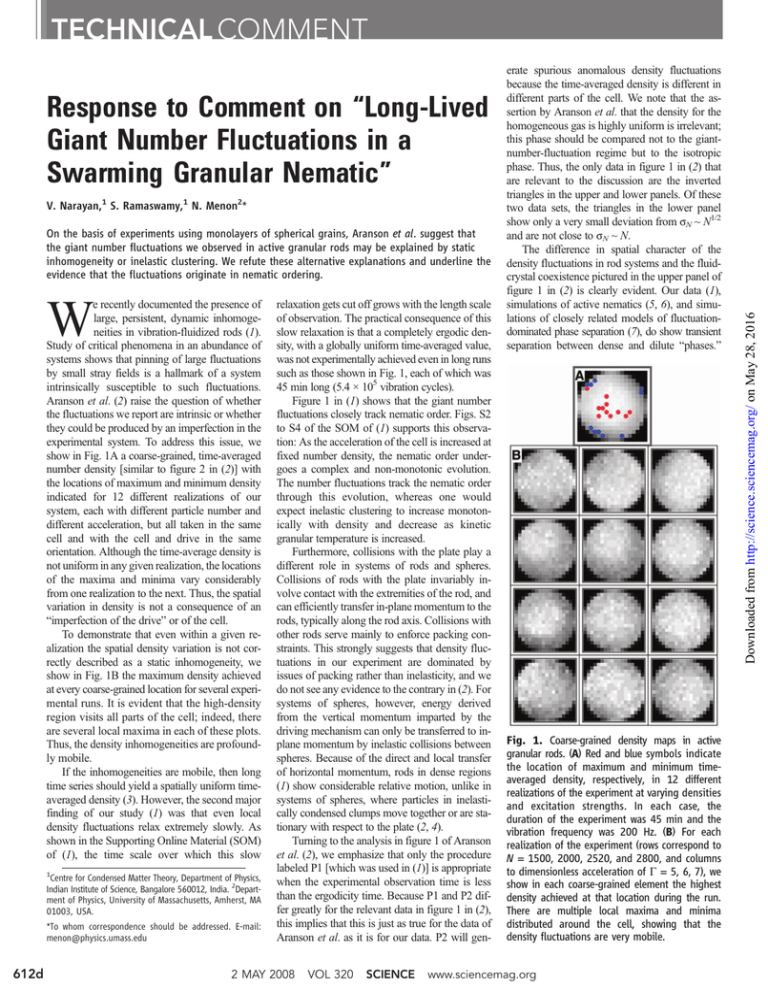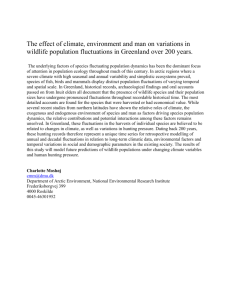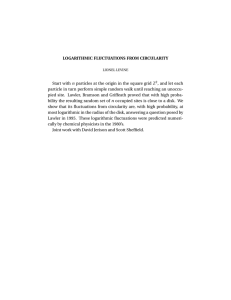
Response to Comment on “Long-Lived
Giant Number Fluctuations in a
Swarming Granular Nematic”
V. Narayan,1 S. Ramaswamy,1 N. Menon2*
On the basis of experiments using monolayers of spherical grains, Aranson et al. suggest that
the giant number fluctuations we observed in active granular rods may be explained by static
inhomogeneity or inelastic clustering. We refute these alternative explanations and underline the
evidence that the fluctuations originate in nematic ordering.
e recently documented the presence of
large, persistent, dynamic inhomogeneities in vibration-fluidized rods (1).
Study of critical phenomena in an abundance of
systems shows that pinning of large fluctuations
by small stray fields is a hallmark of a system
intrinsically susceptible to such fluctuations.
Aranson et al. (2) raise the question of whether
the fluctuations we report are intrinsic or whether
they could be produced by an imperfection in the
experimental system. To address this issue, we
show in Fig. 1A a coarse-grained, time-averaged
number density [similar to figure 2 in (2)] with
the locations of maximum and minimum density
indicated for 12 different realizations of our
system, each with different particle number and
different acceleration, but all taken in the same
cell and with the cell and drive in the same
orientation. Although the time-average density is
not uniform in any given realization, the locations
of the maxima and minima vary considerably
from one realization to the next. Thus, the spatial
variation in density is not a consequence of an
“imperfection of the drive” or of the cell.
To demonstrate that even within a given realization the spatial density variation is not correctly described as a static inhomogeneity, we
show in Fig. 1B the maximum density achieved
at every coarse-grained location for several experimental runs. It is evident that the high-density
region visits all parts of the cell; indeed, there
are several local maxima in each of these plots.
Thus, the density inhomogeneities are profoundly mobile.
If the inhomogeneities are mobile, then long
time series should yield a spatially uniform timeaveraged density (3). However, the second major
finding of our study (1) was that even local
density fluctuations relax extremely slowly. As
shown in the Supporting Online Material (SOM)
of (1), the time scale over which this slow
W
1
Centre for Condensed Matter Theory, Department of Physics,
Indian Institute of Science, Bangalore 560012, India. 2Department of Physics, University of Massachusetts, Amherst, MA
01003, USA.
*To whom correspondence should be addressed. E-mail:
menon@physics.umass.edu
612d
relaxation gets cut off grows with the length scale
of observation. The practical consequence of this
slow relaxation is that a completely ergodic density, with a globally uniform time-averaged value,
was not experimentally achieved even in long runs
such as those shown in Fig. 1, each of which was
45 min long (5.4 × 105 vibration cycles).
Figure 1 in (1) shows that the giant number
fluctuations closely track nematic order. Figs. S2
to S4 of the SOM of (1) supports this observation: As the acceleration of the cell is increased at
fixed number density, the nematic order undergoes a complex and non-monotonic evolution.
The number fluctuations track the nematic order
through this evolution, whereas one would
expect inelastic clustering to increase monotonically with density and decrease as kinetic
granular temperature is increased.
Furthermore, collisions with the plate play a
different role in systems of rods and spheres.
Collisions of rods with the plate invariably involve contact with the extremities of the rod, and
can efficiently transfer in-plane momentum to the
rods, typically along the rod axis. Collisions with
other rods serve mainly to enforce packing constraints. This strongly suggests that density fluctuations in our experiment are dominated by
issues of packing rather than inelasticity, and we
do not see any evidence to the contrary in (2). For
systems of spheres, however, energy derived
from the vertical momentum imparted by the
driving mechanism can only be transferred to inplane momentum by inelastic collisions between
spheres. Because of the direct and local transfer
of horizontal momentum, rods in dense regions
(1) show considerable relative motion, unlike in
systems of spheres, where particles in inelastically condensed clumps move together or are stationary with respect to the plate (2, 4).
Turning to the analysis in figure 1 of Aranson
et al. (2), we emphasize that only the procedure
labeled P1 [which was used in (1)] is appropriate
when the experimental observation time is less
than the ergodicity time. Because P1 and P2 differ greatly for the relevant data in figure 1 in (2),
this implies that this is just as true for the data of
Aranson et al. as it is for our data. P2 will gen-
2 MAY 2008
VOL 320
SCIENCE
erate spurious anomalous density fluctuations
because the time-averaged density is different in
different parts of the cell. We note that the assertion by Aranson et al. that the density for the
homogeneous gas is highly uniform is irrelevant;
this phase should be compared not to the giantnumber-fluctuation regime but to the isotropic
phase. Thus, the only data in figure 1 in (2) that
are relevant to the discussion are the inverted
triangles in the upper and lower panels. Of these
two data sets, the triangles in the lower panel
show only a very small deviation from sN ~ N1/2
and are not close to sN ~ N.
The difference in spatial character of the
density fluctuations in rod systems and the fluidcrystal coexistence pictured in the upper panel of
figure 1 in (2) is clearly evident. Our data (1),
simulations of active nematics (5, 6), and simulations of closely related models of fluctuationdominated phase separation (7), do show transient
separation between dense and dilute “phases.”
Fig. 1. Coarse-grained density maps in active
granular rods. (A) Red and blue symbols indicate
the location of maximum and minimum timeaveraged density, respectively, in 12 different
realizations of the experiment at varying densities
and excitation strengths. In each case, the
duration of the experiment was 45 min and the
vibration frequency was 200 Hz. (B) For each
realization of the experiment (rows correspond to
N = 1500, 2000, 2520, and 2800, and columns
to dimensionless acceleration of G = 5, 6, 7), we
show in each coarse-grained element the highest
density achieved at that location during the run.
There are multiple local maxima and minima
distributed around the cell, showing that the
density fluctuations are very mobile.
www.sciencemag.org
Downloaded from http://science.sciencemag.org/ on May 28, 2016
TECHNICAL COMMENT
Fig. 2. Density autocorrelations showing clear
logarithmic behavior in the giant number fluctuation regime (N = 2820) but not at lower particle density (N = 800, 1500).
However, these phases are not separated by a
sharp interface and appear at all values of wave
vector. The difference between active nematics
and the inelastic clustering shown in the lower
panel of figure 1 in (2) is less obvious. The deviations from N1/2 behavior shown by the inverted triangles in that portion of the figure are
less than compelling. However, the theoretical
and simulational literature on inelastic clustering
(8) includes predictions of power-law tails in the
structure factor (9, 10), just as in the mechanism
driven by nematic fluctuations. To our knowledge, there is no clear experimental evidence of
these power-law tails, and only short-range
correlations have been found.
A possible dynamical signature of the difference between giant number fluctuations in active nematics and in other systems is that even
local density fluctuations relax only logarithmically. Figure 2 shows the autocorrelation of the
number fluctuations at three densities. The
logarithmic relaxation is seen only at the highest
of these densities, when giant number fluctuations are also seen. This is interpreted [SOM of
(1)] as the outcome of local fluctuations being
relaxed by modes at all length scales [see SOM
text for (1)]. The theory of (11) predicts logarithmic relaxation for similar reasons. We are
not aware of similar observations or predictions
in inelastic gases of spheres.
2. I. Aranson, A. Snezhko, J. S. Olafsen, J. S. Urbach, Science
320, 612; www.sciencemag.org/cgi/content/full/320/
5876/612c (2008).
3. Except to the extent that boundary conditions can be
incompatible with the bulk order, as explored in (12).
4. X. Nie et al., Europhys. Lett. 51, 679 (2000).
5. H. Chate, F. Ginelli, R. Montagne, Phys. Rev. Lett. 96,
180602 (2006).
6. S. Mishra, S. Ramaswamy, Phys. Rev. Lett. 97, 090602
(2006).
7. D. Das, M. Barma, Phys. Rev. Lett. 85, 1602 (2000).
8. I. Goldhirsch, G. Zanetti, Phys. Rev. Lett. 70, 1619
(1993).
9. D. R. M. Williams, F. C. MacKintosh, Phys. Rev. E 54, R9
(1996).
10. T. P. C. van Noije et al., Phys. Rev. E 59, 4326
(1999).
11. S. Ramaswamy, R. A. Simha, J. Toner, Europhys. Lett. 62,
196 (2003).
12. J. Galanis et al., Phys. Rev. Lett. 96, 028002
(2006).
13. V.N. and S.R., respectively, thank the Council for
Scientific and Industrial Research, India, and the
IndoFrench Centre for the Promotion of Advanced
Research (grant 3504-2) for support. The Centre for
Condensed Matter Theory is supported by the Department
of Science and Technology, India. N.M. acknowledges
financial support from NSF under grant DMR 0606216.
References and Notes
1. V. Narayan, S. Ramaswamy, N. Menon, Science 317, 105
(2007).
www.sciencemag.org
SCIENCE
VOL 320
18 January 2008; accepted 8 April 2008
10.1126/science.1154685
2 MAY 2008
Downloaded from http://science.sciencemag.org/ on May 28, 2016
TECHNICAL COMMENT
612d
Response to Comment on "Long-Lived Giant Number
Fluctuations in a Swarming Granular Nematic"
V. Narayan, S. Ramaswamy and N. Menon (May 2, 2008)
Science 320 (5876), 612. [doi: 10.1126/science.1154685]
This copy is for your personal, non-commercial use only.
Article Tools
Permissions
Visit the online version of this article to access the personalization and
article tools:
http://science.sciencemag.org/content/320/5876/612.4
Obtain information about reproducing this article:
http://www.sciencemag.org/about/permissions.dtl
Science (print ISSN 0036-8075; online ISSN 1095-9203) is published weekly, except the last week
in December, by the American Association for the Advancement of Science, 1200 New York
Avenue NW, Washington, DC 20005. Copyright 2016 by the American Association for the
Advancement of Science; all rights reserved. The title Science is a registered trademark of AAAS.
Downloaded from http://science.sciencemag.org/ on May 28, 2016
Editor's Summary



